St Chad's Home for Girls, Far Headingley, near Leeds, West Riding of Yorkshire
St Chad's Home for Girls was opened by the Waifs and Strays Society in January 1889 at Glebe House, Hollin Lane, Far Headingley, near Leeds. The official opening was performed by Lady Balfour, with a ceremony of dedication conducted by the Rev. T.C. Smythe.

St Chad's Home for Girls original premises, Far Headingley, Leeds, c.1889. © Peter Higginbotham
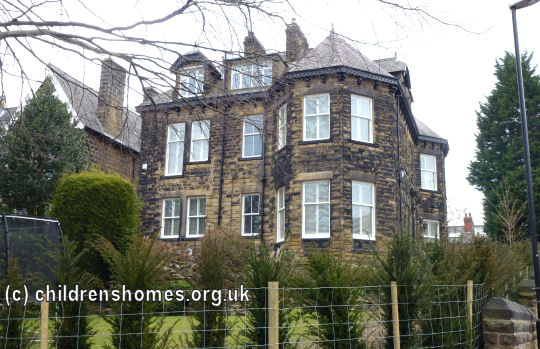
Former St Chad's Home for Girls original premises, Far Headingley, Leeds, 2015. © Peter Higginbotham
The home housed up to 30 orphaned or destitute girls aged from 10 to 15, particularly those who were 'delicate' or disabled and likely to be unsuitable for training as domestic servants. Instead, the home operated a factory knitting socks and stockings made of wool and silk. In 1890, there were twenty girls at work. The ground floor of the house was devoted to the machine-room, finishing-room, store-room, and office. There were nine knitting machines in operation, each able to turn out seven pairs of stockings a day. The stockings were mostly made by machine, and were then taken to the finishing-room to be "toed," and finished by hand. From there they went on to the pressers, who placed them on blocks, and fitted them, by means of heavy irons, into shape. Then they were paired and carded, and passed on to the forewoman for examination. The socks and stockings were knitted in all sizes, and a variety of qualities, from the tiny silken hose of the baby, or the silk or cachemire hose of the lady, to the strongest and coarsest socks for the use of Reformatories, Industrial Schools, and Unions, for which they were made by the gross. The standard of the goods produced was very high and generated a significant income for the home.
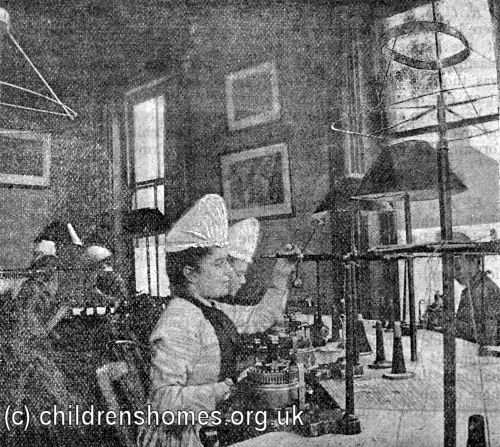
Knitting stockings at St Chad's Home for Girls, Far Headingley, Leeds, c.1889. © Peter Higginbotham
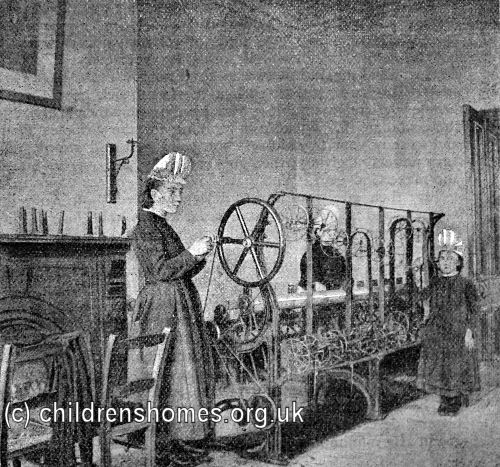
Winding wool at St Chad's Home for Girls, Far Headingley, Leeds, c.1889. © Peter Higginbotham
By 1890, the enterprise had expanded to such a degree that the girls' sleeping quarters were transferred to another property, known as Monk Bridge House, a few minutes walk away on Monk Bridge Road.
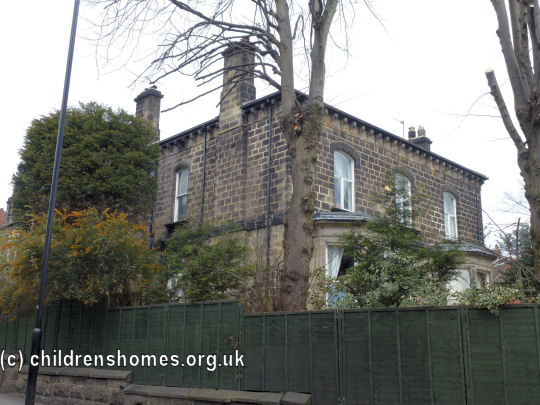
Former St Chad's Home for Girls, Monk Bridge Road, Far Headingley, Leeds, 2015. © Peter Higginbotham
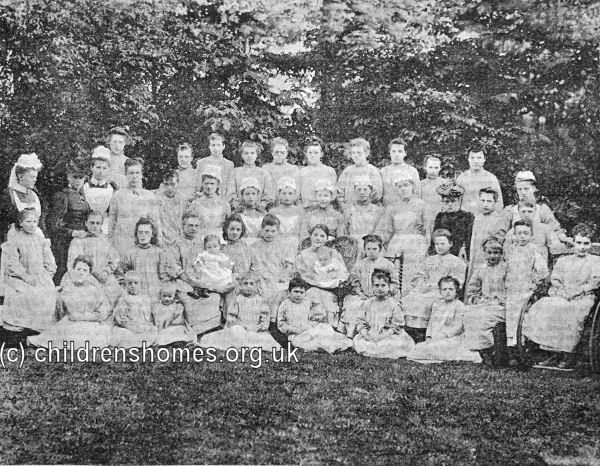
St Chad's Home for Girls, Far Headingley, Leeds, c.1892. © Peter Higginbotham
Before too long, plans were made to erect much larger purpose-built premises for the home. A site was found on Hollin Road and Mr. W. A. Hobson, of Albion Street, Leeds, was appointed as architect. A donation of £3,000 towards the cost of the home was given by Mr. E.W. Beckett, MP, in memory of his late wife. On November 6th, 1893, foundation stones for the new building were laid by Mr Beckett's three children, Lucille, Helen and Ralph. The new home was officially opened by Lucille Beckett on December 1st, 1894, with the Bishop of Richmond conducting a service dedication at St Chad's Church. After the service, a procession made its way to the home headed by a battalion of the Leeds Fire Brigade, in full uniform.
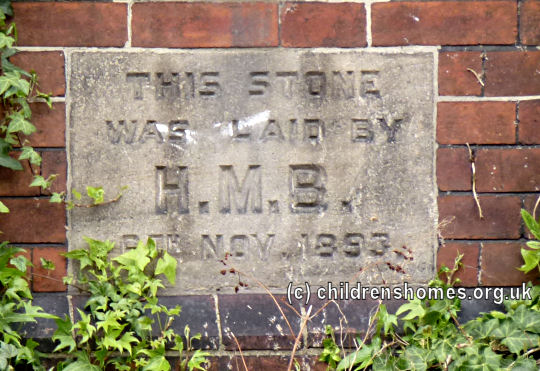
Former St Chad's Home for Girls - Helen's Beckett's foundation stone, Far Headingley, Leeds, 2013. © Peter Higginbotham
The main part of the new building fronted onto Hollin Road and contained accommodation for 78 girls. In the large hall facing the home's entrance porch, a large old oak chimney-piece was installed. This had previously adorned Kirkstall Grange and was another gift from Mr Beckett. The hall substituted as a chapel for daily prayers, was used as a classroom, and also served as a refectory for the Home's staff. To the right was a sitting-room with office for the lady superintendent, and to the left the sewing and outfitting room, and a south-facing hall in which the girls lived, dined and played. Adjacent to this were the kitchen, sculleries and pantries. A stone staircase led to the first floor, on which there were two dormitories with washrooms and bathrooms, and bedrooms for the matrons. A sickroom was isolated from the rest of the house. To the rear of the main building were a laundry block and a manufacturing block.
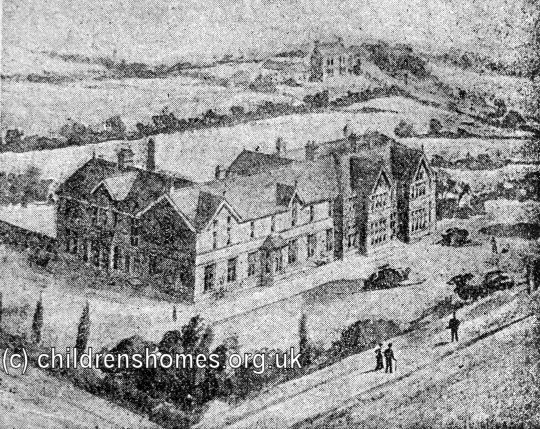
St Chad's Home for Girls new building, Far Headingley, Leeds, c.1894. © Peter Higginbotham
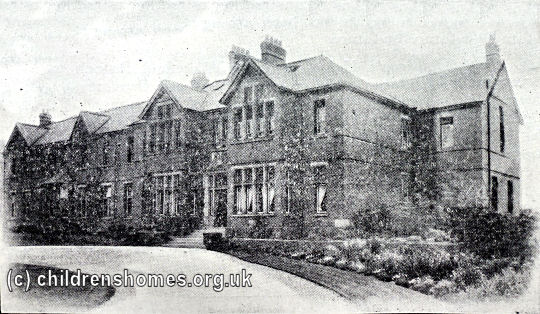
St Chad's Home for Girls, Far Headingley, Leeds, c.1913. © Peter Higginbotham
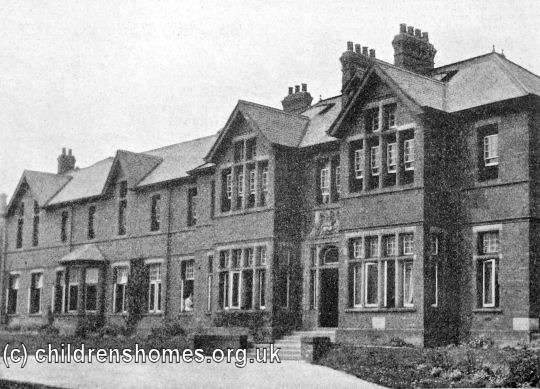
St Chad's Home for Girls, Far Headingley, Leeds, c.1899. © Peter Higginbotham
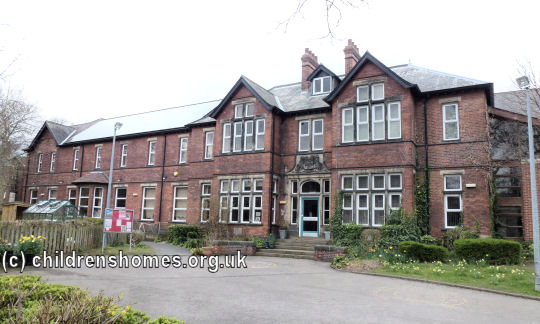
Former St Chad's Home for Girls, Far Headingley, Leeds, 2013. © Peter Higginbotham
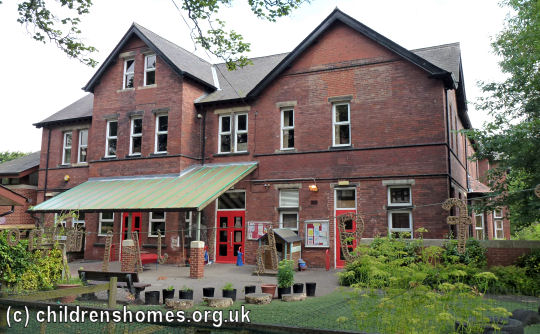
Former St Chad's Home for Girls, Far Headingley, Leeds, 2013. © Peter Higginbotham

Former St Chad's Home for Girls, Far Headingley, Leeds, 2013. © Peter Higginbotham
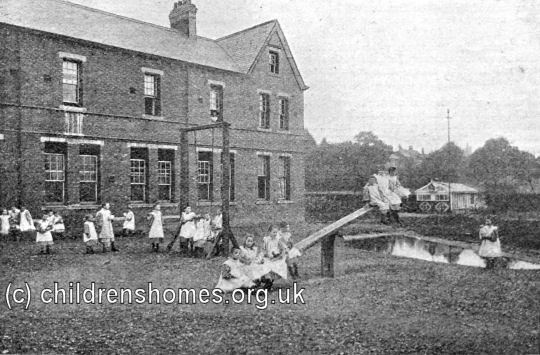
Playground at St Chad's Home for Girls, Far Headingley, Leeds, c.1899. © Peter Higginbotham
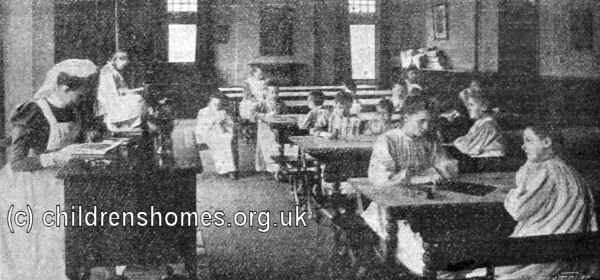
Recreation at St Chad's Home for Girls, Far Headingley, Leeds, c.1899. © Peter Higginbotham
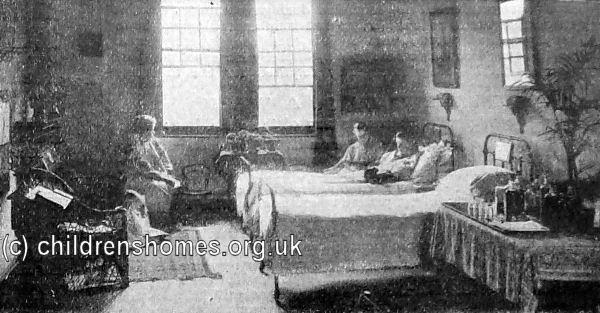
Sick-room at St Chad's Home for Girls, Far Headingley, Leeds, c.1899. © Peter Higginbotham
The Home's sock and stocking making enterprise was successfully transferred to the new building. The range of its production is shown in the price list below issued in 1898.

Stocking price list, St Chad's Home for Girls, Far Headingley, Leeds, 1898. © Peter Higginbotham
The new laundry facilities also became the basis of another successful business. Part of an 1899 account of the Home's laundry and manufacturing activities is given below.
[In the laundry] the whole business of washing — from the sorting and numbering of the things on their arrival on Monday, to their re-sorting and packing on Friday — is carried on by the girls themselves. Everything is done methodically and in order. In the wash-house all are provided with clogs and rubber aprons. Some of the girls scrub at the various troughs which line one side of the room; some preside over the washer, transferring the dripping clothes as they become clean to the wringing-machine. This is turning 1,200 times a minute, so it is not long before every drop of water is squeezed out and the clothes are transferred to the drying-room.
The scene in the ironing-room is just as busy. The industrious young workers are all arrayed in their pink print frocks and white aprons. Down the middle of the room table-cloths are being ironed, and on the left under-linen, whilst in one corner the ironing and glazing of shirts and other fine things goes on. This is the most important and difficult part of the business. The girls all look intent on their work. Many have such bright faces, and look so full of fun, that one can imagine that they will thoroughly enjoy the game of play that comes later on. That there is never a lack of work can easily be imagined when I say that the washing for eighty different families is done in the Home.
Not by any means less interesting than the laundry is the Stocking Knitting-room. Twenty-two girls are engaged on this. Some of them are winding wool on to the bobbins ready for the machines. Others are working away steadily at the machines themselves. Others, again, are finishing off the stockings — sewing the two edges of the toes together, and carefully examining the work to see that there are no dropped stitches anywhere. Then they are handed over to the "presser," who with a very hot iron gets every crease out until the stocking is quite smooth.
That the girls are energetic will be understood when I say that they knitted 11,000 pairs of stockings in one year, They have had much encouragement to help them on, for besides receiving a Bronze Medal and Diploma at the World's Fair in Chicago, in 1893, they have been honoured by Royal patronage, which is, of course, much appreciated.
An important branch of their work is that of making episcopal silk stockings. These have been patronised by several bishops, besides the Archbishop of York. They also have the contract for St. Anne's School, Redhill, which brings in regular work to the Home.
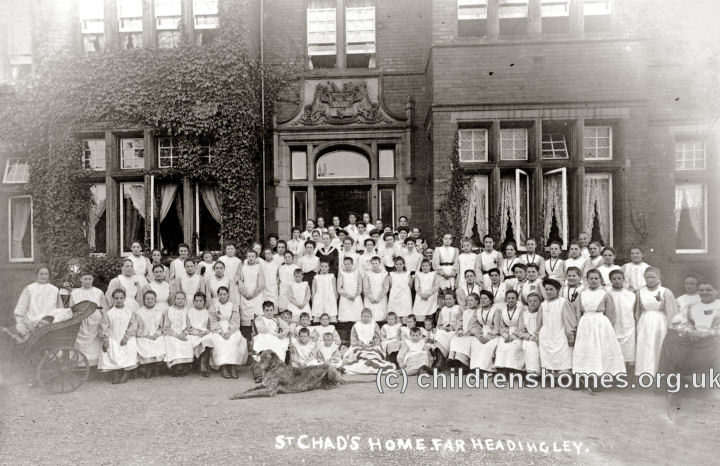
Inmates of St Chad's Home for Girls, Far Headingley, Leeds, early 1900s. © Peter Higginbotham
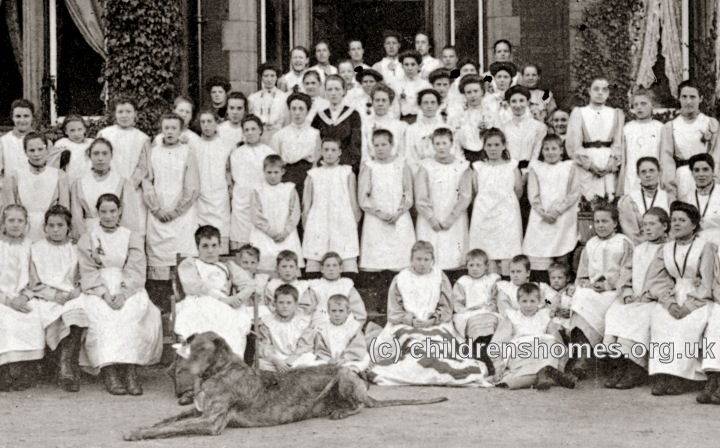
Inmates of St Chad's Home for Girls (detail), Far Headingley, Leeds, early 1900s. © Peter Higginbotham
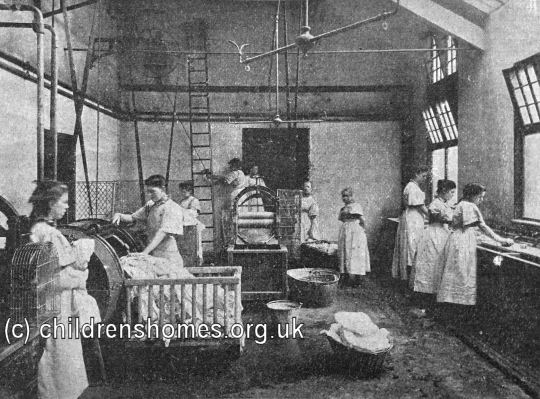
Laundry at St Chad's Home for Girls, Far Headingley, Leeds, c.1899. © Peter Higginbotham
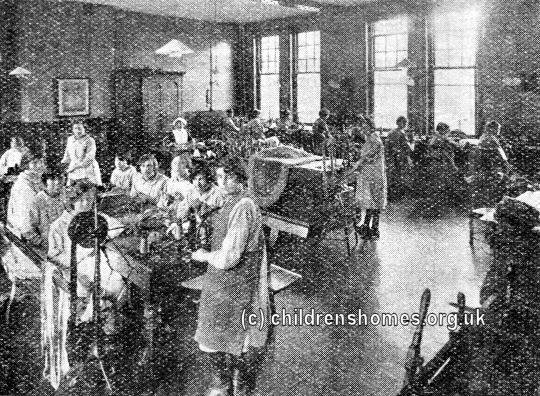
Knitting room at St Chad's Home for Girls, Far Headingley, Leeds, c.1929. © Peter Higginbotham
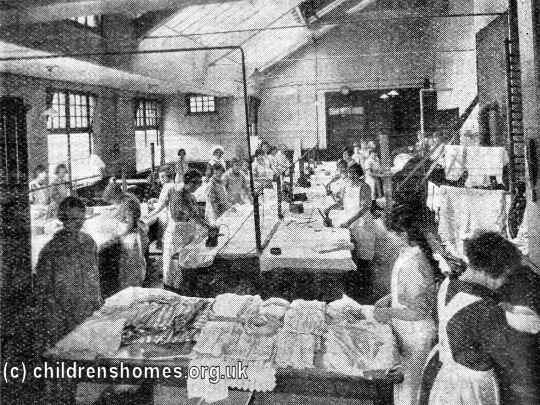
Ironing room at St Chad's Home for Girls, Far Headingley, Leeds, c.1929. © Peter Higginbotham
Here is an advertisement for the home's wares from 1931.

Laundry at St Chad's Home for Girls, Far Headingley, Leeds, c.1931. © Peter Higginbotham
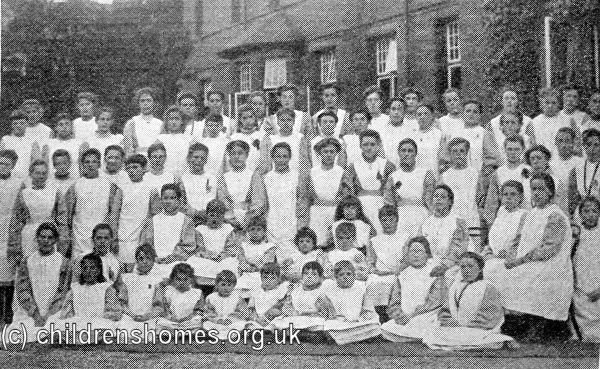
St Chad's Home for Girls, Far Headingley, Leeds, c.1913. © Peter Higginbotham
Many of the residents of St Chad's joined the Girl Guides, with all their uniforms being made in the home.
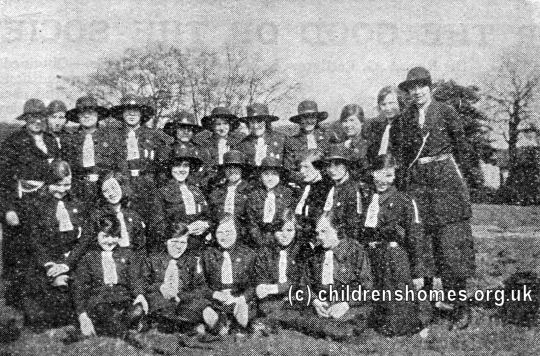
St Chad's Home for Girls, Far Headingley, Leeds, c.1927. © Peter Higginbotham
A holiday at the seaside was a feature of most summers. Filey was a favourite destination.
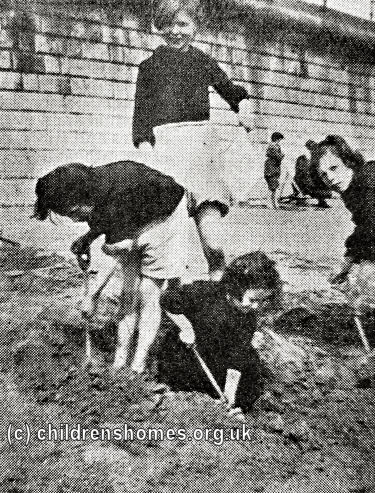
St Chad's girls at Filey, 1925. © Peter Higginbotham
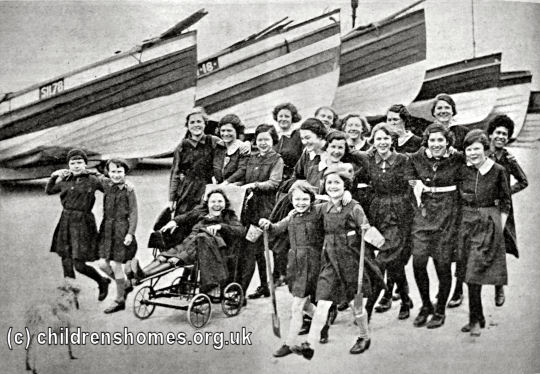
St Chad's girls at Filey, 1935. © Peter Higginbotham
Some of the girls at St Chad's did end up in domestic service in the area and often kept in contact with the home and with one another, with occasional group gatherings or outings being organised.

St Chad's Service Girls outing to Shipley Glen, 1925. © Peter Higginbotham
There were also occasional reunions of the home's 'old girls'.
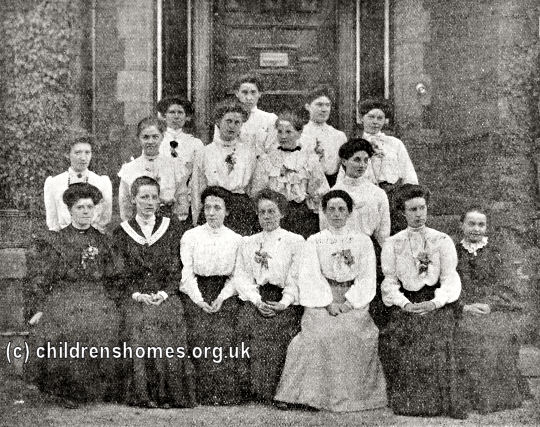
St Chad's girls' reunion, c.1908. © Peter Higginbotham
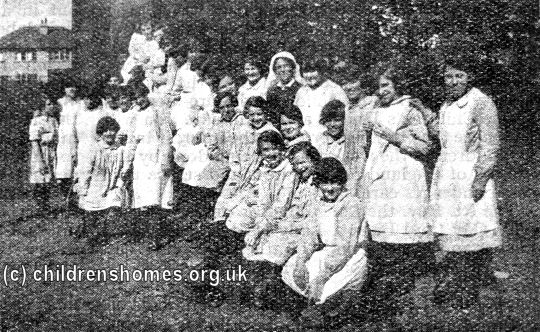
St Chad's Home for Girls, Far Headingley, Leeds, c.1929. © Peter Higginbotham
The home closed at the outbreak of the Second World War in 1939 when the premises were commandeered for use as an Air Raid Precaution post.
The property was later taken over by Leeds Education Authority as student accommodation, originally known as St Chad's Hostel then later as Hollin Hall. Since 1995, the building has been occupied by Weetwood Primary School.
Records
Note: many repositories impose a closure period of up to 100 years for records identifying individuals. Before travelling a long distance, always check that the records you want to consult will be available.
- Index of the Society's first 30,000 children's case files ordered by surname.
- Index of the Society's first 30,000 children's case files ordered by date of birth.
- The Children's Society Records and Archive Centre is at Unit 25, Springfield House, 5 Tyssen Street, London E8 2LZ (email: archives@childrenssociety.org.uk). Files for children admitted to its homes after September 1926 were microfilmed in the 1980s and the originals destroyed. Some post-1926 files had already been damaged or destroyed during a flood. The Society's Post-Adoption and Care Service provides access to records, information, advice, birth record counselling, tracing and intermediary service for people who were in care or adopted through the Society.
- The Society has produced detailed catalogues of its records relating to disabled children, and of records relating to the Children's Union (a fundraising body mostly supported from the contributions of children).
Bibliography
- Bowder, Bill Children First: a photo-history of England's children in need (1980, Mowbray)
- Church of England Waifs and Strays' Society [Rudolfe, Edward de Montjoie] The First Forty Years: a chronicle of the Church of England Waifs and Strays' Society 1881-1920 (1922, Church of England Waifs and Strays' Society / S.P.C.K.)
- Higginbotham, Peter Children's Homes: A History of Institutional Care for Britain's Young (2017, Pen & Sword)
- Morris, Lester The Violets Are Mine: Tales of an Unwanted Orphan (2011, Xlibris Corporation) — memoir of a boy growing up in several of the Society's homes (Princes Risborough, Ashdon, Hunstanton, Leicester) in the 1940s and 50s.
- Rudolf, Mildred de Montjoie Everybody's Children: the story of the Church of England Children's Society 1921-1948 (1950, OUP)
- Stroud, John Thirteen Penny Stamps: the story of the Church of England Children's Society (Waifs and Strays) from 1881 to the 1970s (1971, Hodder and Stoughton)
Links
- Hidden Lives Revealed — the story of the children who were in the care of The Children's Society in late Victorian and early 20th Century Britain.
- The Children's Society
Except where indicated, this page () © Peter Higginbotham. Contents may not be reproduced without permission.


